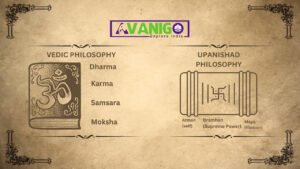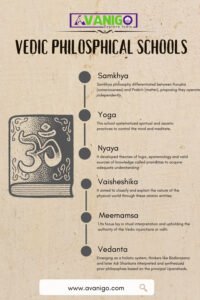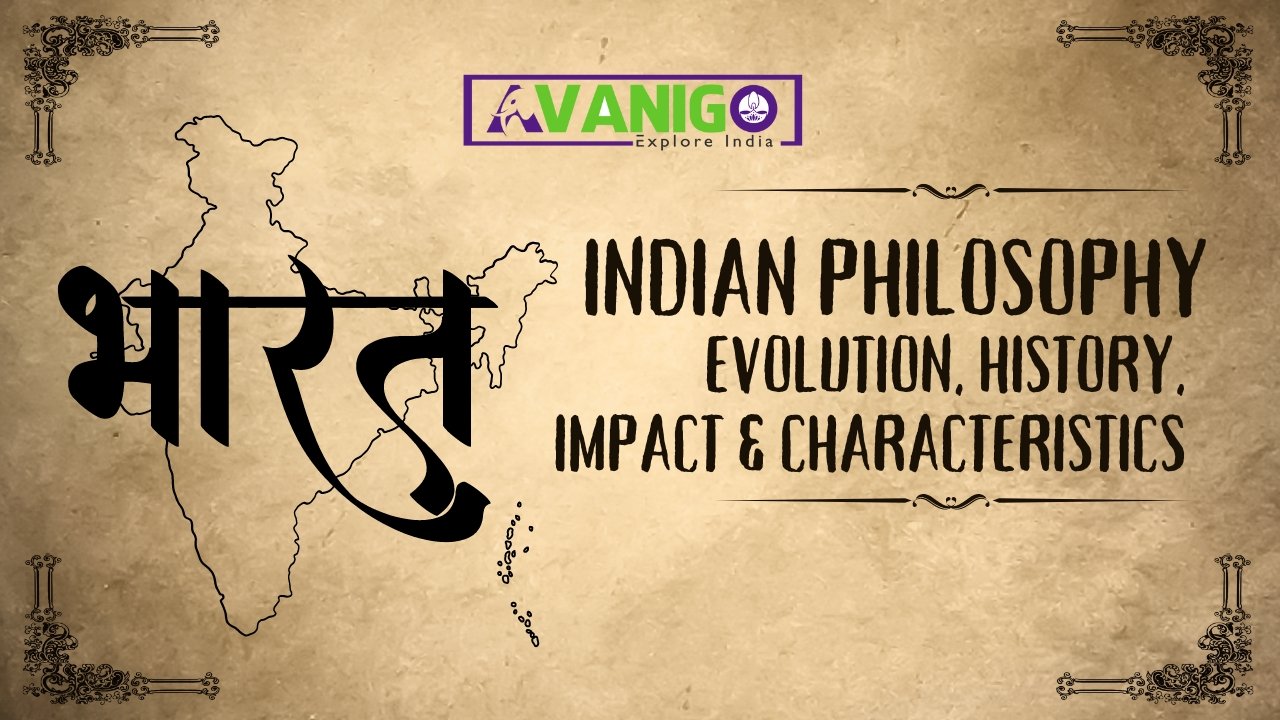India has long been a wellspring of sophisticated thought plumbed by generations of scholars. Its dizzying diversity belies philosophical lineages nurtured for millennia through open, dialectical exchange. While many works celebrate individual systems, discerning the evolution of Indian philosophy as an organic renaissance illuminates India’s gifts to global discourse. Let us embark on an anthropic journey across eras to appreciate the flourishing philosophy of India.
Quick Navigation
The Vedic Foundations of Indian Philosophy
The Vedic age in India, which started about 1500 BCE, is when Indian philosophy had its start. During this period, intricate ideas about the essence of reality were documented in the Vedic texts known as the Samhitas and the Brahmanas.
Fundamental to Vedic philosophy were notions such as dharma, karma, samsara and moksha. The focus of philosophy during the Vedic age in India, where it was called as Bharat, revolved around comprehending humanity’s place in the universe and establishing rituals.
As time progressed, new scriptures emerged circa 800 BCE called the Upanishads. Often regarded as parts of the Vedas, these Upanishads delved into some of the metaphysical musings of early Indian philosophy.
Central themes explored in these texts included atman (the self), Brahman (the reality), and the concept of Maya (the illusion of appearances). Works like the Brihadaranyaka Upanishad, Chandogya Upanishad, and Isha Upanishad, among others, examined spiritual inquiries.
The philosophical ideas from Vedic literature and Upanishadic teachings set a foundation for various schools that would emerge in later epochs. Contemplations on metaphysics, epistemology, logic, and principles like karma, moksha, and samsara have shaped Indian philosophical thought.

The Six Orthodox Darshanas
While the Vedic era planted many philosophical seeds, classical Indian thought consolidated these diverse perspectives into coherent systems known as “darshanas” between 600-100 BCE. Chief among the six primary orthodox schools were:
- Samkhya: One of the earliest schools, founded by Kapila, Samkhya philosophy differentiated between Purusha (consciousness) and Prakriti (matter), proposing they operate independently. It saw the goal as liberating purusha from the influences of Prakriti through discriminative knowledge.
- Yoga: Closely associated with Samkhya, Yoga school contains systematized spiritual and ascetic practices to control the mind and meditate. The eight-limbed route described in Patanjali’s Yoga Sutras includes yama, niyama, and pratyahara to attain kaivalya and enhanced perception.
- Nyaya: A system which emphasizes reason, logic, and appropriate inquiry, was started by Akshapada Gautama. It developed theories of logic, epistemology and valid sources of knowledge called pramāṇas to acquire adequate understanding and dispel ignorance.
- Vaisheshika: Founded by Kanada, this system delved deep into atomism and proposed all objects in the world as combinations of invisible, eternal and everlasting atoms. It aimed to classify and explain the nature of the physical world through these atomic entities.
- Mimamsa: Associated primarily with Jaimini and Shabara Swami, this scholastic tradition emphasized orthopraxy over philosophical speculation. Its focus lay in ritual interpretation and upholding the authority of the Vedic injunctions or vidhi.
- Vedanta: Emerging as a holistic system, thinkers like Badarayana and later Adi Shankara interpreted and synthesized prior philosophies based on the principal Upanishads. Shankara’s Advaita Vedanta strongly influenced Hindu philosophy through non-dualism.
Together, these schools represented the diverse intellectual flowering of Vedic philosophy. While each emphasized unique perspectives, they shared core beliefs like karma, rebirth, dharma and moksha as spiritual goals. Let us now turn to the thriving intellectual scene of heterodox darshanas.

Heterodox Alternatives of Indian Philosophy
Developing alongside these orthodox schools were several concurrent “nastika” or heterodox philosophies challenging aspects of Vedic authority and thought between 500-100 BCE:
- Buddhism: Founded by Gautama Buddha, this tradition diverged significantly by rejecting concepts of atman and the authority of the Vedas.
- Jainism: A contemporaneous school established by Mahavira around the same time as Buddha. It emphasized non-violence and rejection of Vedic theism in favour of its interpretations.
- Charvaka: An atheistic and materialist philosophy attributed to Brihaspati and Lokayata. Influenced by early materialism, it denied karma and rebirth concepts and focused solely on sensory experience.
These traditions represented an open, pluralistic spirit welcoming diverse perspectives of Indian philosophy, in contrast to some regions tending toward single orthodoxies. Their debates and challenges helped strengthen philosophies on all sides.
- Fact: Are you aware that Vasudhiava Kutumbakam – the timeless Indian philosohpy is the child of the vedic and upanishad philosphies. Such thought process is what makes India country profile venerable in the world.
Fundamental Concepts of Indian Philosophy
While different philosophies disagreed on crucial points, several fundamental concepts recurred throughout ancient and classical Indian thought. Some of the most important ideas that shaped perspectives across schools included:
- Dharma: Often translated as “duty,” “virtue”, or the “natural order,” dharma refers to moral, social and cosmic order.
- Karma: The universal cosmic law of cause-and-effect governing actions and their fruits, understood as determining rebirth.
- Moksha/Nirvana: Liberation from samsara or the cycle of rebirth through enlightenment or self-realization, seen as humanity’s ultimate aim.
- Samsara: The perpetual cycle of birth, life, death and rebirth governed by karma and conditioned existence.
- Brahman: In Vedanta, the unqualified, infinite, eternal, unseen reality is the omnipresent, absolute truth and source of all existence.
- Atman: Often translated as “self” or “soul,” atman refers to the eternal essence or principle of sentience within living beings.
- Drishti-Srishti Vada: The viewpoint that perception or cognition shapes reality, an idea connected to idealism.
- Pramāṇa: Valid sources or means of knowledge extensively analyzed by various traditions.
While there were significant differences between philosophies, these core concepts recurred as foundations for diverse Indian metaphysical thinking through the centuries.
Medieval developments in Indian Philosophy
In medieval times, several Hindu philosophy significantly expanded the classical frameworks:
- Theistic schools integrated philosophy with devotion by interpreting notions like Brahman as a personal God. Visistadvaita Vedanta of Ramanujacharya and Dvaita Vedanta of Madhvacharya exemplify this trend.
- Tantric traditions incorporated esoteric ritual practices and symbolism into philosophical doctrines. Kashmiri Shaivism and Buddhist Tantra notably developed new metaphysical understandings through this approach.
- Bhakti movements emphasized an emotional, devotion-centered path, leading many from ritualism to metaphysical speculation. Poet-saints like Tulsidas and Basavanna contributed to both religious renewal and philosophical discourses.
- Yuktibhasa rationalized Buddhism by critically engaging Greek, Persian and Indian logical thinkers. Dignaga and Dharmakirti established a new tradition of Buddhist logic and epistemology.
This period bred novel eclectic syntheses as diverse currents interacted. Philosophies explored more profound questions like the ultimate reality’s nature, the relationship between God and soul, the means of moksha, and how spiritual liberation relates to worldly life.
Modern Resurgence and Future Directions of Indian Philosophy
While classical Indian thought declined temporarily under colonial rule, several modern thinkers helped revitalize interest from the 19th century onward, including:
- Swami Vivekananda promoted Vedanta internationally through the Ramakrishna Mission.
- Aurobindo synthesized evolution and spirituality in works integrating yoga with Vedanta.
- Sarvepalli Radhakrishnan stressed harmony between Eastern and Western thought.
- Contemporary exponents like Ramana Maharshi renewed neo-Advaita Vedanta’s popularity.
While ancient universities in India were shaped by the early Indian philosophies, today, leading universities worldwide advance critical studies of classical and contemporary Indian thought. Charismatic modern gurus also spread ancient teachings to new generations globally.
Meanwhile, scholars creatively engage Indian philosophies with diverse fields, from science to ecology. This way, dynamic rediscovery and recontextualization ensure Indian wisdom’s continued evolution and relevance for many years. The Ancient India gave birth to notable geniuses like Aryabhatta, while the Modern India is a home to prodigies like Srinivasa Ramanujan.
A Wellspring of Perennial Insights
The philosophical contemplations that began in ancient India 3,000 years ago have generated a vast and diverse heritage. While each era and school offered unique insights, common threads of spiritual ideals like dharma, moksha, and ahinsa persisted through changing times. From the Vedas to the modern day, the philosophy of India remains a dynamic, evolving tradition focused on illuminating humanity’s most profound questions. Its myriad insights shaped the Indian culture in a profound way and will continue inspiring new generations worldwide to explore the timeless truths of existence.

